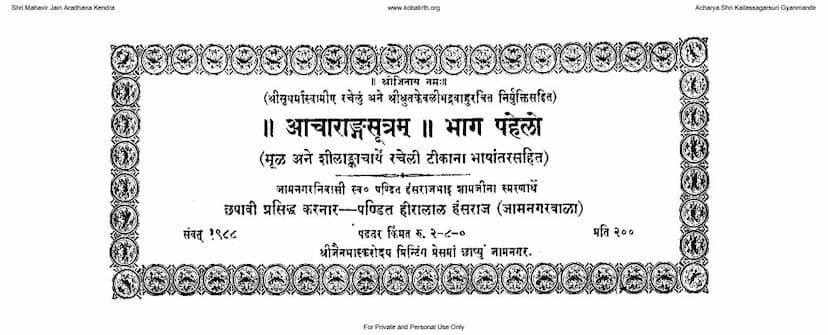Acharanga Stram Part 01
Added to library: September 1, 2025

Summary
This is a comprehensive summary of the provided text, which appears to be a Gujarati translation and commentary of the Acharanga Sutra, Part 1, by Acharya Shilankacharya. The summary is based on the provided text, focusing on the philosophical and ethical tenets of Jainism as presented in the Acharanga Sutra.
Summary of Acharanga Sutra, Part 1 (Based on the provided text):
The Acharanga Sutra, as presented in this text, is a foundational scripture of Jainism, originally composed by Acharya Sudharmaswami and with commentary by Acharya Bhadrabahusuri, and further elaborated by Acharya Shilankacharya. This text is a translation of Acharya Shilankacharya's commentary, aiming to explain the core principles of Jain conduct and philosophy.
Core Themes and Concepts:
- The Goal of Liberation (Moksha): The ultimate aim of the Acharanga Sutra is to guide individuals towards liberation from the cycle of birth and death (samsara). This is achieved through strict adherence to the principles of Jainism.
- The Importance of Conduct (Achar): The title itself, "Acharanga," highlights the paramount importance of conduct. The sutra meticulously details the ethical principles and practices that a Jain mendicant (and by extension, a layperson) must follow.
- Fourfold Classification of Knowledge (Anuyogas): The text categorizes Jain knowledge into fourfold paths:
- Dharmakathanuyoga: Knowledge related to religious discourse and teachings.
- Ganitanuyoga: Mathematical and astronomical knowledge.
- Dravyanuyoga: Knowledge of the fundamental nature of reality and substances.
- Charanakarana Anuyoga: The path of conduct and practical ethics, considered the most crucial as it directly leads to liberation. This section emphasizes that other anuyogas support and explain the Charanakarana Anuyoga.
- The Ideal Ascetic (Acharya): The text elaborates on the thirty-six essential qualities of an ideal Jain acharya, who is the spiritual guide. These qualities encompass wisdom, ethical conduct, compassion, detachment, knowledge of scriptures, understanding of different viewpoints, and the ability to teach effectively.
- The Nature of the Soul and Reality: While the initial focus is on conduct, the underlying philosophy touches upon the soul (Atman) and its relationship with the universe. The text alludes to the complex philosophical debates surrounding the nature of the soul, its existence, and its journey through different states of being.
- The Path of Non-Violence (Ahimsa): Ahimsa is the cornerstone of Jainism. The Acharanga Sutra emphasizes extreme non-violence in thought, word, and deed. This extends to all living beings, including even the smallest microscopic organisms (referred to as "nigoda" and "ekendriya"). The text details how various actions, even seemingly minor ones, can cause harm and thus lead to karmic bondage.
- Karma and its Consequences: The doctrine of karma is central. All actions, whether physical, verbal, or mental, generate karma, which binds the soul to the cycle of rebirth. The sutra aims to explain how to minimize karmic influx and shed existing karma.
- Detailed Classification of Living Beings: The text delves into the classification of living beings based on their senses (ekendriya, dvindriya, etc.) and their existence in different realms of the universe. It highlights the subtle nature of some life forms, like those in water and earth, and emphasizes the need for extreme caution in all actions.
- The "Upadesha Dwaras" (Methods of Instruction): The text outlines several "dwaras" or methods used in explaining the scriptures, including Upakrama (introduction), Nikshepa (classification), Anugama (analysis), and Nayavada (philosophical viewpoints). These are presented as tools for understanding the profound teachings.
- Nishkashay (Freedom from Passions): The ideal path involves eradicating passions like anger, pride, deceit, and greed (kashayas) as they are the root cause of suffering and karmic bondage.
- Renunciation and Austerity (Tapas): The path to liberation involves rigorous asceticism and austerity, including fasting, self-control, and detachment from worldly pleasures.
- The Significance of "Nishchaya" and "Vyavahara": The text touches upon the distinction between the ultimate reality (Nishchaya) and conventional reality (Vyavahara). While Vyavahara provides practical guidance, Nishchaya points to the ultimate nature of the soul and liberation.
- Detailed Analysis of Specific Conducts: The text, through Shilankacharya's commentary, provides detailed explanations for various aspects of conduct, such as:
- Paryapti (Fulfillment): The process by which beings attain the necessary physical and mental faculties.
- Shatras (Weapons/Harmful Acts): Identifying actions that cause harm, especially in relation to different life forms like earth-bodied, water-bodied, fire-bodied, air-bodied, and vegetation-bodied beings.
- Rituals and Practices: Explaining the significance and proper execution of various rituals and practices for mendicants.
- The Importance of a Guru: The text emphasizes the crucial role of a qualified guru in guiding the disciple on the path to spiritual enlightenment.
Overall Purpose:
The Acharanga Sutra, as interpreted by Shilankacharya, serves as a comprehensive guide for spiritual practice in Jainism. It emphasizes that true spirituality is not just about knowledge but about the diligent and unwavering application of ethical principles in daily life, with the ultimate goal of achieving purity of the soul and liberation from worldly suffering. The commentary likely aims to clarify the intricate details of Jain conduct for practitioners, ensuring adherence to the highest ideals of Ahimsa and spiritual discipline.